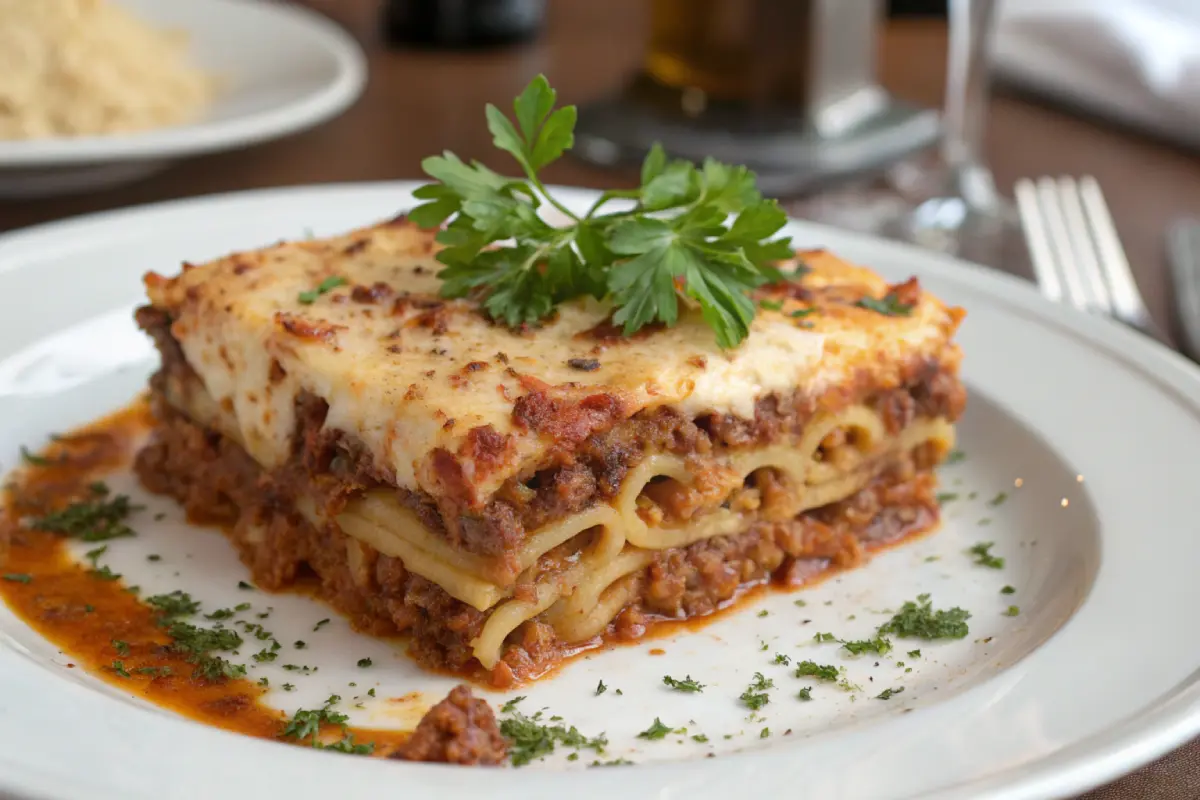Greek cuisine is known for its bold flavors, comforting dishes, and a deep connection to tradition. Among its culinary gems is Pastitsio Greek Beef Pasta Bake, a hearty, layered pasta bake that’s often called Greece’s answer to lasagna. This dish is a celebration of flavors—rich, cinnamon-spiced meat sauce, creamy béchamel, and perfectly cooked pasta, all baked to golden perfection.
In this comprehensive guide, we’ll dive into everything you need to know about Pastitsio, from its origins and ingredients to step-by-step preparation and serving ideas. Whether you’re a seasoned cook or trying this dish for the first time, you’re in for a treat. Let’s begin with a closer look at what makes Pastitsio so special.
Introduction to Pastitsio Greek Beef Pasta Bake
What is Pastitsio?
At its core, Pastitsio is a Greek pasta bake that combines layers of tender pasta, a rich meat sauce, and a thick, cheesy béchamel topping. It’s similar to lasagna but boasts a unique twist thanks to Greek spices like cinnamon and cloves. These flavors set it apart, giving it an unmistakable Mediterranean flair.
This dish isn’t just food; it’s a symbol of celebration, often served during holidays, family gatherings, and special occasions. Its striking layers—pasta on the bottom, meat sauce in the middle, and béchamel on top—create a visual and culinary masterpiece.
Origin and Historical Significance in Greek Cuisine
Pastitsi
o Greek Beef Pasta Bake has deep roots in Greek culture. The name derives from the Italian word “pasticcio,” meaning a pie made with pasta. However, the Greek version has evolved into a dish all its own. Traditionally, it was a meal of abundance, prepared with locally sourced ingredients and designed to feed a crowd.
Over time, it has become a beloved staple in Greek households and a must-try for visitors exploring Mediterranean cuisine. Its use of bucatini pasta and aromatic spices reflects Greece’s rich culinary history, blending influences from neighboring regions while maintaining its unique identity.
Why Pastitsio is More Than Just a Pasta Bake
There’s more to Pastitsio than meets the eye. It’s a labor of love, requiring attention to detail and patience to achieve the perfect balance of textures and flavors. The cinnamon-spiced meat sauce brings warmth and depth, while the creamy béchamel offers a luxurious finish. Together, they create a dish that’s not only satisfying but deeply comforting.
Whether you’re drawn to its cultural heritage or simply its incredible taste, Pastitsio is a dish that deserves a spot in your kitchen repertoire. Ready to make it? Stick around for the next part as we uncover the essential ingredients that bring this classic to life.
Key Ingredients of Pastitsio Greek Beef Pasta Bake
Traditional Greek Bucatini or Alternatives
At the heart of any Pastitsio Greek Beef Pasta Bake is the pasta layer. Traditionally, Greek cooks use a special thick tubular pasta known as bucatini or “Pastitsio No. 2.” Its unique shape, with a hollow center, helps it hold sauces beautifully. If you can’t find this specialty pasta, don’t fret. Small ziti, penne, or even regular bucatini work just as well.
The pasta isn’t just cooked and layered; it’s tossed with crumbled feta and egg whites. This mix not only adds flavor but also binds the pasta, creating those neat slices Pastitsio is famous for. When shopping, look for bucatini at Mediterranean stores or online for an authentic touch.
The Unique Role of Cinnamon and Clove in the Meat Sauce
One of the defining features of Pastitsio is its meat sauce, and what sets it apart is the warm spice blend. A hint of cinnamon and a touch of clove transform a basic meat sauce into something undeniably Greek. These spices, paired with red wine and rich tomato paste, infuse the sauce with depth and character.
Unlike traditional Italian meat sauces, the Greek version is thicker. This consistency keeps the layers distinct, ensuring that the flavors don’t blend into one another. taking the time to simmer the sauce properly is key to achieving the right texture.
Kefalotyri Cheese and Its Substitutes
The top layer of Pastitsio wouldn’t be the same without Kefalotyri cheese. This hard, salty cheese is made from sheep’s or goat’s milk, offering a savory tang that balances the dish’s richness. If Kefalotyri isn’t available, Parmesan or Romano make excellent substitutes.
Sprinkling this cheese over the béchamel sauce before baking creates a golden, crispy crust. Whether you use traditional Kefalotyri or its substitutes, this final touch elevates the dish to a new level of indulgence.

Step-by-Step Guide to Making Pastitsio Greek Beef Pasta Bake
Preparing the Pasta Layer: Feta Toss and Egg Binding
Start by cooking your chosen pasta until it’s just shy of al dente. Once drained, toss it with crumbled feta cheese and beaten egg whites. This step isn’t just about adding flavor—it ensures the pasta sets firmly, making those clean slices possible.
Crafting the Greek-Style Meat Sauce: Tips for Thick, Flavorful Results
For the meat sauce, begin by sautéing garlic and onion in olive oil. Add ground beef and cook until browned. Pour in a generous splash of red wine, allowing it to simmer until reduced. Next, mix in crushed tomatoes, tomato paste, and spices like cinnamon, cloves, and bay leaves.
Perfecting the Greek Béchamel Sauce
The béchamel sauce in Pastitsio is thicker than its Italian counterpart. To make it, start by melting butter and whisking in flour to create a roux. Gradually add milk while stirring continuously to avoid lumps. Once thickened, remove the pot from the heat and mix in egg yolks, grated cheese, and a pinch of nutmeg.
This sauce should be pourable but thick enough to hold its shape. If it cools and thickens too much, gently reheat it to restore its consistency.
Assembling the Layers for a Perfect Slice
To assemble, spread the pasta layer evenly in the dish. Pour the cooled meat sauce on top, smoothing it out for an even layer. Finally, pour the béchamel sauce over the meat, ensuring it covers the surface completely. Sprinkle the top with grated Kefalotyri or Parmesan.
Bake the dish until the top turns golden and bubbly. Let it rest for at least 15 minutes before slicing. This resting period allows the layers to set, making for clean, beautiful cuts that showcase the distinct components of Pastitsio.
Tips and Tricks for the Best Pastitsio Greek Beef Pasta Bake
Common Mistakes to Avoid when making Pastitsio Greek Beef Pasta Bake
When making Pastitsio, precision is key. One common error is overcooking the pasta, which can turn it mushy during baking. Always cook it a minute or two less than the package suggests. Similarly, don’t rush the meat sauce. Letting it simmer not only thickens it but also deepens the flavors
Another pitfall is skipping the cooling step for the sauce. A hot meat sauce can cause the layers to blend, ruining the visual appeal. Allowing the sauce to cool helps create those distinct layers that make Pastitsio a feast for both the eyes and the taste buds.
Make-Ahead and Storage Tips for Busy Cooks
One of the best things about Pastitsio is its versatility. You can assemble it a day in advance and store it in the fridge. On the day of serving, simply bake it and enjoy! It also freezes well, making it perfect for meal prep. Just thaw and reheat in the oven for a dish that tastes as fresh as the day it was made.
Enhancing Flavors for an Authentic Taste
For a truly Greek experience, use authentic ingredients like bucatini and Kefalotyri cheese. If these aren’t available, opt for substitutes such as penne or Parmesan, but remember, the spices are non-negotiable. Cinnamon and clove bring that unique Mediterranean flair, elevating your dish from good to unforgettable.
Serving Suggestions and Pairings
Greek Salad: A Classic Companion
Nothing complements the rich layers of Pastitsio better than a refreshing Greek salad. The crisp cucumbers, juicy tomatoes, and tangy feta balance the dish’s heartiness. Drizzle with olive oil and sprinkle with oregano for an authentic touch.
Other Side Dishes to Complement Pastitsio Greek Beef Pasta Bake
For a complete Mediterranean feast, serve Pastitsio with warm pita bread or roasted vegetables. Dishes like Ultimate Vegan Baked Ziti offer a lighter alternative for guests who prefer plant-based options. These pairings enhance the meal without overpowering its flavors.
Beverage Pairings: Wine and More
A full-bodied red wine, such as Cabernet Sauvignon or Merlot, pairs beautifully with Pastitsio. If you prefer something non-alcoholic, a refreshing lemon balm tea can cleanse your palate while complementing the dish’s rich flavors.
For more Mediterranean recipe ideas, check out A Tasty Recipes to expand your culinary repertoire.
Variations of Pastitsio
Vegetarian and Vegan Alternatives
For those who don’t eat meat, Pastitsio Greek Beef Pasta Bake can easily be adapted into a vegetarian dish. Replace the meat sauce with a hearty mix of lentils or mushrooms. These substitutes provide a meaty texture while absorbing the bold spices like cinnamon and clove. For a vegan version, swap the béchamel with a plant-based white sauce made from almond or cashew milk. Nutritional yeast can replace Kefalotyri cheese to maintain that savory flavor.
This version isn’t just lighter—it’s also a great way to introduce the Mediterranean classic to a broader audience. the dish’s beauty lies in its adaptability.
Gluten-Free Options for the Pasta Layer
A gluten-free Pastitsio is just as delicious with a few simple changes. Use gluten-free pasta, such as rice or quinoa-based varieties, and replace the flour in the béchamel sauce with cornstarch or a gluten-free flour blend. These swaps allow those with dietary restrictions to enjoy the classic without compromising on taste or texture.
Regional Twists on the Classic Recipe
Different regions in Greece add their spin to Pastitsio. Some include layers of eggplant or zucchini, giving it a hint of moussaka. Others incorporate lamb instead of beef for a richer, more traditional flavor. No matter the variation, the result is always a celebration of Greek culinary heritage.
FAQs About Pastitsio Greek Beef Pasta Bake
What Pasta Can Substitute for Greek Bucatini?
Traditional Greek bucatini, known as “Pastitsio No. 2,” might not be easy to find. Don’t worry—small ziti, penne, or even regular bucatini work just as well. These alternatives still give you that distinctive layered look when sliced. the choice of pasta affects appearance, not flavor.
Can Pastitsio Greek Beef Pasta Bake Be Frozen and Reheated?
Absolutely! Pastitsio is a great make-ahead dish. Once baked, let it cool completely before freezing. Wrap it tightly in foil or store it in an airtight container. When ready to enjoy, thaw it in the fridge overnight and reheat it in the oven at 350°F until warmed through. This method preserves its flavor and texture beautifully.
What Makes the Greek Béchamel Sauce Different?
Unlike Italian béchamel, the Greek version used in Pastitsio is thicker and more custard-like. The addition of egg yolks and a higher flour-to-milk ratio gives it this unique texture. This thicker sauce ensures the top layer holds its shape, creating those clean, neat slices.
Conclusion: Celebrating Greek Culinary Artistry
Pastitsio Greek Beef Pasta Bake as a Culinary Bridge Between Cultures
Pastitsio isn’t just a dish; it’s a celebration of Greek culture and flavors. Its rich layers of pasta, spiced meat sauce, and creamy béchamel capture the heart of Mediterranean cooking while echoing influences from Italy and beyond. this dish beautifully bridges traditions, bringing a unique twist to classic comfort food.
Why Every Food Lover Should Try This Dish
Whether you’re savoring its authentic version or a creative variation, Pastitsio offers something for everyone. Its bold flavors, satisfying textures, and versatility make it a must-try for anyone passionate about food. Why wait? Dive into the flavors of Greece today!

